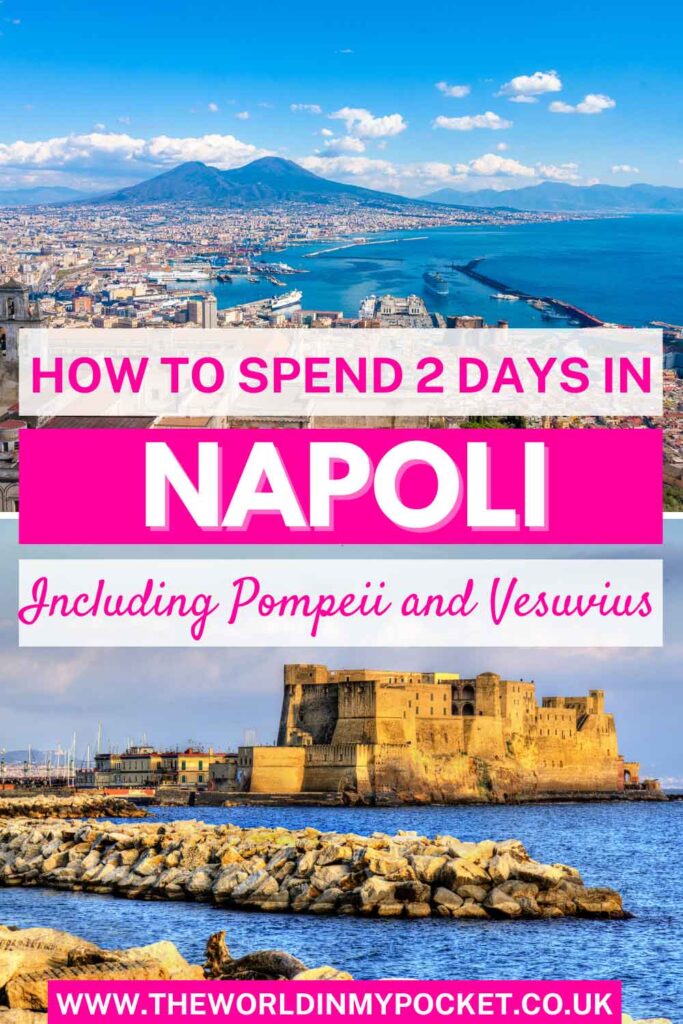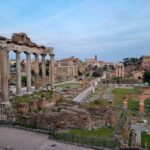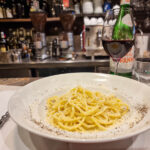Napoli is one of my favourite cities in Italy. It’s the bad boy of the country, a rebel on the outside, but extremely sweet and interesting on the inside. This year I returned to Napoli with my friends who had never been, so I was in charge of planning the itinerary, to include all the main spots and the best places to eat, so they get a taste of what the city is all about. And I thought, why not share my perfect two days in Naples itinerary with you as well?
We landed on Friday evening, after a very delayed flight, but we were still welcomed with open arms by the owner of the apartment we rented for the two days. And not just arms, but also limoncello and chocolates.
Getting From the Airport to the City – Avoid the Scams!
I told you that Napoli is quite the rebel, therefore, you have to pay attention to scams and pickpockets. One of the main scams in the city is the taxi from the airport into town. Even if the price is fixed and clearly displayed in the taxi bays, the drivers will try to ask you up to three times more, claiming that the information hasn’t been updated in years. Don’t believe them, the price is fixed.
Now, when you land close to midnight, you don’t want to argue with a greedy taxi driver. So pass by them, and head over towards the bus station. On the way you will find the shared taxis, which have a fixed price of 5 euros/person – that they respect. For an extra 2 euros, they will drop you off in front of your accommodation.
My Perfect 2 Days in Napoli Itinerary
Day 1:
Piazza del Plebiscito

As our apartment was minutes away, we started this 2 days in Napoli itinerary with a visit to Piazza del Plebiscito, one of the city’s largest and most impressive squares, covering 25,000 square meters.
It was originally intended to celebrate Napoleon’s invasion but was later named after the plebiscite of 1860, which brought Naples into the unified Kingdom of Italy. The piazza’s spacious, open design makes it a popular spot for public events, concerts, and gatherings.
On one side of the square, there is the Royal Palace of Napoli, facing the Basilica of San Francisco di Paola on the exact opposite.
Basilica of San Francesco di Paola

The Basilica of San Francesco di Paola is one of Naples’ most striking churches, located on the west side of Piazza del Plebiscito. Its design, inspired by the Pantheon in Rome, features a grand portico with six columns and two Ionian pillars, leading into a large, circular nave topped with a dome.
The basilica was commissioned by Ferdinand I in 1817, following the fall of Napoleon, as a gesture of gratitude to Saint Francis of Paola for the Bourbon restoration. Its construction was completed in 1846. Inside, the basilica is beautifully decorated with a mix of neoclassical and baroque elements, it has a marble high altar and a frescoes covered dome.
The basilica is free to visit, but make sure to wear appropriate clothing, covering your knees and shoulders.
Napoli Sotterranea

Napoli Sotterranea, or Naples Underground, is a network of tunnels, caverns, and ancient cisterns that dates back over 2,400 years. Originally dug out by the Greeks to extract tuff stone, these passages were later expanded by the Romans and used for water storage. During World War II, they even served as bomb shelters.
The ticket for this guided tour costs 11 euros and you can book a ticket by clicking here.
I highly recommend booking the tickets in advance. We showed up for the 10 am tour but it was already sold out, so we reserved tickets for 11. And this was in early March. I can imagine that in summer, during the peak season, you can’t visit unless you book the tickets in advance. You can only go in the underground with a guided tour. There is one English tour an hour.

The tour starts with a descent down a narrow staircase, about 40 meters below street level. It’s a bit claustrophobic at first, but once you get used to it, the cool, dimly lit tunnels feel quite atmospheric. Our guide was incredibly knowledgeable, combining stories of ancient history with tales of wartime survival.
We explored the empty old cisterns that were used as shelters during the Second World War, and crawled through narrow passageways, through walls. It’s amazing how much history lies hidden beneath the street level.
Royal Palace of Napoli

We passed by the Royal Palace of Napoli, on the way to Castel dell Ovo. We checked out the interior courtyard, which is free to visit, but we didn’t have time to visit the royal rooms and the grand staircase. If you want to visit, the ticket costs 10 euros.
Castel Nuovo

Castel Nuovo, also known as Maschio Angioino, is a medieval castle one of Naples’ most prominent landmarks. It is located near the port, just a short walk from Piazza del Plebiscito. The entrance fee is 6 euros.
The castle is pretty impressive, with its medieval, Renaissance and Gothic architectural styles. Built in the 12th century, it is one of the oldest fortresses in Napoli, which has gone through several modifications under different rulers. The most interesting feature of the castle is the Triumphal Arch which is decorated with sculptures and reliefs showing Alfonso V’s entry into the city. The arch was built in the 15th century to commemorate the arrival of Alfonso V of Aragon to Napoli.
Street Food Lunch

For lunch, we decided to try some of the best street food in Napoli. I went for a typical panino Napoletano, which is a roll filled with a lot of cheese and pancetta, baked in the oven. My friends went for a selection of frittata, arancini, and potato croquettes, which were all delicious. We bought them from Espressioni Popolari, a tiny hole in the wall on Via Toledo. Their cacio e pepe frittata was out of this world, I’m still dreaming of that unique taste.
Funicular

With our stomachs full, we headed to the funicular to catch a ride up to the Vomero district. The funicular is a quick and fun way to ascend the steep hills of Napoli, as well as a symbol of the city. Who doesn’t know the famous Funiculi, funicula song?
Castel St Elmo

By the time we reached Castel St Elmo, it was already 4:30 in the afternoon. Upon reaching the entrance, we noticed that from 5 pm the entrance was free, so we walked a little bit around the castle, then returned half an hour later. Before 5, the price of the ticket is 5 euros.
Castle St Elmo is a star-shaped fortress built on top of the Vomero hill, offering panoramic views over Napoli and the bay of Napoli.
The history of Castel Sant’Elmo dates back to the 10th century when it was initially built as a church dedicated to Saint Erasmus. In the 14th century, the site was transformed into a military fortress in the shape of a six-pointed star, to provide defence from all angles. During the 17th and 18th centuries, the castle was also used as a prison.

The views from the top are breathtaking. You can see in all directions, spot Capri and Ischia, and see as far as the airport.
TIP: Take the funicular up and use the stairs to go down the hill. The stairs are brutal – very long and quite steep in places.
Quartieri Spagnoli

From Castel St Elmo, we descended back into the city, via the stairs. Going down was hard enough, I can’t imagine using them to go up! The stairs led us back to Quartieri Spagnoli, the Spanish Quarter. This is one of the most lively neighbourhoods of Napoli. It has narrow streets – so narrow that sometimes it’s hard to move away when a car is coming, it has an authentic, gritty charm, and is buzzing with people. On the maze of streets, we passed by small grocery shops, tiny trattorias, and even some sort of religious procession.
Castel dell’Ovo

Just as the sun started to go down, we made our way towards Castel dell’Ovo and the famous Margellina promenade. Castel dell’Ovo is one of the oldest still-standing fortifications in Napoli and usually, it’s free to visit. However, during our trip, there was a lot of construction going on around it, and the castle was temporarily closed. If it’s open when you visit, make sure to walk up the ramparts and take in the different panoramic views of the city from the top.
Drinks on the Promenade

We wrapped up our first day in Napoli with a relaxing stroll along the Lungomare, the waterfront promenade, which was packed with locals. We found a couple of what I can only call “drinks trucks” with plastic tables and chairs with a prime view towards the sea, and we sat down. We bought a couple of beers and enjoyed them with a view of the bay and Vesuvius in the background.
Dinner at Trattoria Piazzetta Sant’Anna

We had a late dinner at Trattoria Piazzetta Sant’Anna, a restaurant very close to our apartment. We loved them so much the first night, when they were the only place open at midnight when we arrived in Napoli, that we returned again. The food was plentiful, home-cooked, and absolutely delicious – exactly what you would expect from Napoli. Whilst I do understand the hype of going to famous places such as Da Michele or other TikTok famous places, it’s the hidden restaurants where you will have the most amazing experience. This is because they don’t have crowds of people waiting at their doors, they don’t hurry, and they make food with love. This restaurant is a family business, and the man of the house is quite the character, calling himself Pavarotti and randomly just bursting into singing.
Between us, we ordered quite a few dishes, all of which were so delicious. I had an amazing pizza stuffed with cheese on the first night and pasta with potatoes – a Neapolitan speciality – on the second. Together with drinks, we both paid around 15 euros each for a massive dinner.
Day 2:

The first part of the second day of this Napoli itinerary is dedicated to Pompeii and Vesuvius. I did consider the pros and cons of going on our own or getting a tour and decided on the latter. This is because, in March, I wasn’t sure how often the bus to Vesuvius runs from Pompeii. Also, due to our short stay in Napoli, we wanted to make the most of it and not waste time with public transport. Also, cost-wise, there wasn’t a big difference, especially since the organised tour offered lunch as well. We used this company for our tour, and we paid 80 euros each. It included pickup from a central location (in our case Piazza Plebiscito), transport, a guide on the minibus, entry tickets to Pompeii and Vesuvius, a guided tour of Pompeii, as well as a three-course lunch with drinks. Optional, for an extra fee, they also offer an extra wine tasting.
Pompeii

We started our day early, as our pickup for Pompeii was at 8 am. Not before stopping for a quick coffee, at the little café around the corner from the apartment. You have to love Italy and their 1,5 euro cappuccinos!
Pompeii is one of the world’s most fascinating sites, and a must when you visit Napoli. This was actually my first time visiting Pompeii so I was very excited to learn more about the infamous city which was covered by ash by the catastrophic eruption of Vesuvius, in 79 AD.
Pompeii is thought to have been founded sometime around 9-8th century BC, by Greek colonists. The Romans didn’t arrive here until 298-290 BC when it was captured after a three long years war. Run as an autonomous region, Pompeii didn’t become a Roman colony until 80 BC. This is when the city started to flourish and grow. Its glory didn’t last for long. In 62 AD the city suffered severe damage from a devastating earthquake which turned out to be the warning of the catastrophe that happened just a few years later.

It is astonishing how preserved Pompeii actually is. Our tour included a local guide, who spent two hours inside the archaeological site with us, bringing the buildings to life through her stories. We visited many villas with incredibly preserved mosaics and frescos, we’ve seen the local baths, the forum remains of street kitchens, the indents in the pavement where horses used to be tied, ancient graffiti, and even visited a brothel.
Vesuvius

I think we can all agree that Vesuvius is one of the most famous volcanoes in the world. Whilst many think that Vesuvius is extinct or even dormant, it is actually a still very active volcano which didn’t erupt in a while. Its last eruption was between 1913–1944 and lasted for 30 years!
However, Vesuvius is monitored, so it’s safe to go up to the crater. The drive takes around 40 minutes, on windy roads, between dried lava and burned tree trunks. The car park is at the entrance of the national park. The guide gave us one and a half hours to climb Vesuvius and then return to the bus.

It takes around 30 minutes to reach the crater. The path is quite steep and uneven, due to the volcanic soil. Unfortunately for us, the crater was covered in clouds so we didn’t get much of a view of Napoli and its bay, below. However, we did get a glimpse into the crater, once we reached the top. From place to place I could see sulfur gas rising from underneath the rocks.
Just before the crater, there is a small shop that sells cold drinks, wine, and souvenirs, if you forget to bring water with you. We walked halfway around the crater, before returning to the bus. The path stops and you can’t go around the crater in a full circle.
Sfogliatella From Mary

Coming back from the tour, we were dropped off just behind Galeria Umberto I. So, it was the perfect occasion to introduce my friends to the greatest pastry in Napoli, the sfogliatella from Mary. This tiny Pasticceria is so popular that there is always a queue. But don’t worry, it goes fast. The sflogliatellas are always warm, just taken out of the oven. Due to their popularity, they don’t have time to cool down before they are sold.
If you haven’t been to Napoli before, you may wonder what a sfogliatella even is. Coming in two different versions, sfogliatellas are the best thing that will happen to your taste buds during this trip. They are delicious pastries filled with sweet ricotta cheese, flavoured with lemon zest. My favourite is the sfogliatella frolla, which has a short crust dough rather than crispy layers of filo. It is also less messy to eat.
Spaccanapoli

With sfogliatellas in hand, we strolled along Spaccanapoli, towards Piazza Dante. Via Toledo or Spaccanapoli as it is often referred to, is a straight line street that cuts straight through the historic centre of the city. Part of it is pedestrian, and it always seems to be packed with locals. There are plenty of shops, cafes and restaurants on both sides of the street. We encountered quite a few street performances as well, which we thought might have been related to Easter, as we were visiting just before the holiday.
See the Presepes

Napoli is famous for its Presepes, which are miniature nativity scenes, carefully crafted by hand. The scenes go way beyond just the nativity scenes though. Years ago, when I first visited Napoli, this area used to be much more authentic. I am not going to lie, I was a bit disappointed by all the kitsch that has taken over the original alleyway. However, I still found a few original presepes and a workshop where I could see the artisans working on the tiny figurines.
Via San Gregorio Armeno is the best place to see these intricate, handcrafted displays. The workshop was on Vico Santa Luciella.
Pizza Al Portafoglio For Dinner

After the filling three-course meal lunch we decided that for dinner we would have a pizza to go rather than sit down at a restaurant. We wanted to try the pizza at portafoglio, which is specific to Napoli. There are two places in the area where we were that are famous for their pizza.
One is da Michele, which you probably know, is the place where pizza was invented. There is always a queue in front of the restaurant but, many don’t know, that you can actually order a pizza to go, in a different queue. And this is much faster. The second one is Sorbillo, where we ended up getting the pizza. I went for a Neapolitan classic: the friarielli and salsiccia pizza. This combination is synonymous with Napoli and it consists of a pizza topped with a type of broccolini and sausage. It was delicious!
Drinks at La Tupaia Vineria

After we finished our pizzas, we sat down at an outdoor terrace, just off the main street. We were attracted by their large selection of wines, not just from Campania but from all over Italy. And their low prices, with most glasses being priced at under 5 euros.
Piazza Dante
We ended our fantastic two days in Napoli in Piazza Dante, a lively square that is very popular at night with locals. There are a few large restaurants and bars around it, some of which have live music.
A little tip: if you want to enjoy 2 euros Aperol Spritz, head behind Piazza Dante, to Caffè dell’Epoca.
Where to Stay in Naples

As we were a group of four friends, we decided to book an apartment rather than stay in a hotel. We chose Napule Loft, located in the Spanish Quarter, five minutes walk away from Piazza del Plebiscito. The host waited for us to arrive, as our flight was late and introduced us to the apartment, which had a double bedroom, two twin beds in the loft area, and a couch on the ground floor. It had a fully working kitchen with a coffee machine, a cosy dining area, and a small terrace.
We were welcomed with limoncello and chocolate, and the day before departure, the host left by the door a bag with four fridge magnets for us. It was such a nice touch!
We paid £200 in total for 2 nights. You can check the current price of the apartment on Booking.
For more similar articles, check out my recommendations below:
- The best food tour in Napoli
- Things to do in Napoli in winter
- Things to know before travelling to Napoli
Like it? Pin it!

Disclaimer: Some of the links on this website are “affiliate links.” This means that if you click on the link and do a purchase, I will receive an affiliate commission at no extra cost for you. This helps me keep my website running and continue to share my travelling knowledge with you. I thank you for booking your flights or hotels using the links on my website. Regardless, I only recommend products or services I use personally and believe will add value to my readers.





I totally agree with you that Naples is indeed a rebel. Actually, my friend had an awful experience due to theft and discouraged us from visiting due to safety concerns. However, after reading your post — it’s definitely worth visiting. Not to mention that the food scene looks amazing. Appreciate the tips and will just need to be a little bit more careful once we decide to visit.
Happy to know that you still found a few original presepes. They are beautiful.
This 2 day Naples itinerary is full of activities but didn’t feel like rushing you to enjoy the city. For me, taking the stairs back to the city from Castel St Elmo sounds great so I can be hungry to try different food in town. lol. I will take a tour to visit Pompeii and Vesuvius, too, especially for my first visit. The tip about taxis will be helpful!
I have been to Napoli only once, and this is a long time ago. We also spent one day exploring Pompeii, but as we went by public transport, we could not include Vesuvio on the same day. Reading your post I want to go back and explore more of the city, like the Sotteranea and the funicular.
Although we have been to Naples but it was just on transit. We took the bus from the airport to Sorrento immediately after we reached. On our journey back too we took a train from there to Rome. Therefore have always felt that we should have stayed there as well for a couple of days. It was so nice seeing all the landmarks here. Napoli Sotterranea reminded me of one we has walked through in Zagreb Croatia. Basilica would be interesting as I always love them for the history attached.